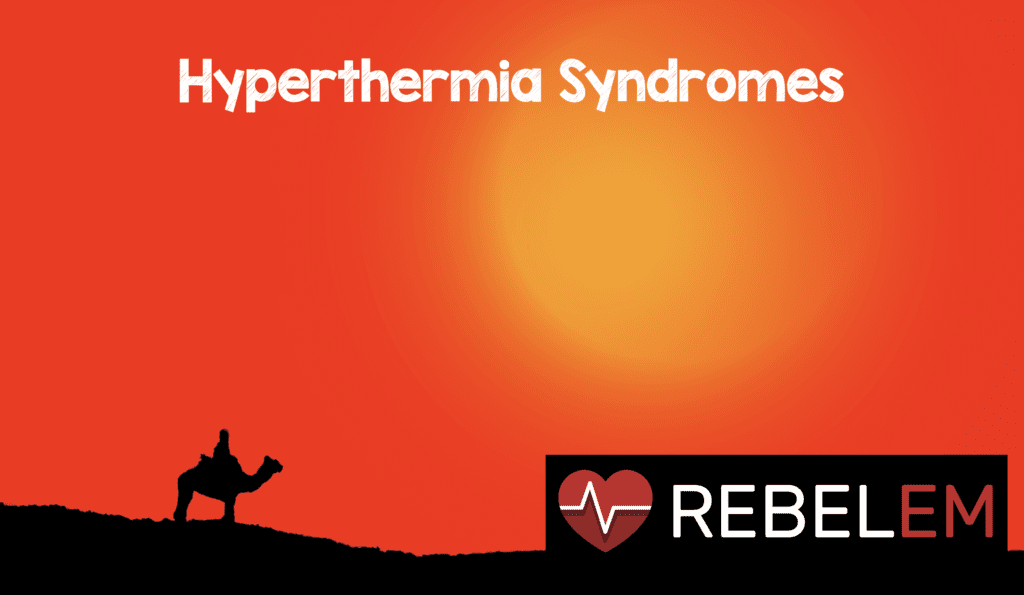
Categories of Heat Illness
- Minor Heat Illness
- Heat Cramps: Intermittent muscle cramps likely related to salt deficiency
- Heat Edema: Swelling of the feet and ankles typically in non-acclimatized people
- Heat Syncope: Caused by peripheral vasodilation of decrease venous return
- Prickly Heat: Vesicular rash caused by obstruction of the sweat gland pores
- Heat Exhaustion
- Moderate temperature Elevation (typically < 40oC)
- Caused by volume depletion secondary to heat stress
- Variant forms: water depletion, salt depletion
- Symptoms + Signs
- Nonspecific symptoms: Weakness, fatigue, headache, nausea/vomiting, muscle cramps
- Syncope
- Orthostatic hypotension
- Continued sweating
- Intact neurologic function
- Management
- Serum electrolyte measurement to help guide fluid management
- Symptomatic management
- Heat Stroke
- Physiologic Changes in Heat Stroke
- Cardiovascular
- Hypodynamic states seen in elderly (or those with compromised cardiac function at baseline)
- Hyperdynamic states in young patients
- Mild volume depletion
- Edema and hemorrhage in the GI tract occur (likely due to regional ischemia)
- Acute kidney injury (AKI)
- Contributors: volume depletion, hypotension, myoglobinuria
- Coagulopathy
- Electrolyte disturbances: hypernatremia, hyperkalemia, hypophasphatemia, hypocalcemia
- Cardiovascular
- Clinical Manifestations
- Vital Sign Abnormalities
- Hyperthermia (typically > 41oC)
- Tachypnea
- Tachycardia
- Hypotension
- Hot, dry skin with absence of sweating
- CNS dysfunction: altered mental status, seizures, coma
- Vital Sign Abnormalities
- Physiologic Changes in Heat Stroke
Differential Diagnosis
- Sepsis
- Sympathomimetic intoxication (sweating usually present)
- Anticholinergic intoxication (sweating absent)
- Sedative-hypnotic withdrawal
- Serotonin toxicity
- Malignant hyperthermia
- Neuroleptic malignant syndrome
- Severe decompensated hyperthyroidism (i.e. thyroid storm)
Management
- Basic Interventions
- Large bore IV access X 2, supplemental oxygen (pre-oxygenation for possible RSI), cardiac monitor
- Consider early airway management for altered mental status or seizure activity
- Continuous core temperature monitoring (i.e. rectal or esophageal probe, bladder probe)
- Finger stick glucose
- There is no role for the use of antipyretics in hyperthermia management (hypothalamic thermoregulation is not affected)
- Aggressive external cooling measures
- Patients should be rapidly cooled (< 30 min) to a target temperature of 38.3oC (101oF)
- Ice bath immersion is superior to other forms of cooling (Ferris 1938, Costrini 1990, Armstrong 1996, Gaffin 2000, Vassallo 2015)
- Remove from ice bath at 38.3oC to prevent iatrogenic hypothermia
- Delays in cooling are associated with high morbidity and mortality (Dematte 1998)
- Patients should be rapidly cooled (< 30 min) to a target temperature of 38.3oC (101oF)
- Treat agitation and shivering with benzodiazepines to prevent excess heat generation
- Diagnostic Testing
- Serum labs
- Basic metabolic panel
- Common electrolyte abnormalities (hypoNa, hypoK, hypoCa, hypophosphatemia)
- Acute kidney injury
- Hepatic panel
- ALT/AST rise + peak within 48 hours
- Fulminant hepatic failure may be seen
- Cardiac biomarkers
- Troponin often elevated but may be unclear if type I (coronary occlusion) or type II ischemia
- Creatine kinase (CK)
- Muscle breakdown common in younger patients resulting from physical activity or agitation
- CK levels do not correlate with severity of rhabdomyolysis or AKI
- Urinalysis
- Can reveal rhabdomyolysis (+ blood with minimal or no RBCs on micro)
- Can reveal concomitant urinary infection
- Basic metabolic panel
- EKG
- Nonspecific ST and T wave changes are common
- Ventricular tachydysrhythmias (VF + VT) can occur
- Serum labs
- Differentiating sepsis from heat stroke can be difficult unless there is a clear exposure history (i.e. sports related). Additionally, patients can have both infection and heat stroke concomitantly. It is not unreasonable to administer broad spectrum antibiotics if there is a suspicion for an infectious process.
Disposition
- All patients with heat stroke should be admitted to a critical care unit to monitor for rebound hyperthermia, electrolyte abnormalities and multi system organ dysfunction
- Heat Exhaustion
- Young otherwise healthy patients can typically be discharged home
- Older patients with significant comorbid conditions should be considered for admission
- Be cautious in discharging patients if they are going to be at risk for recurrent hyperthermia (i.e. returning to same non-air conditioned apartment)
Take Home Points
- Heat stroke is a life-threatening disorder characterized by elevated core temperature, compromise to neurologic function and multi-system organ dysfunction
- The keystone of treatment is rapid cooling within 30 minutes of presentation preferably with ice water immersion
- Patients with heat stroke should be investigated for rhabdomyolysis, AKI, liver failure and concomitant infection
For More on This Topic Checkout:
- LITFL: Hyperthermia
- LITFL: Heat Stroke
- LITFL: Hyperthermia-Associated Toxidromes
- Steve Carroll at EM Basic: Hyperthermia
References:
- Ferris EB et al. Heat stroke: clinical and chemical observations on 44 cases. J Clin Invest. 1938;17:249–262. PMC: 424982
- Costrini A. Emergency treatment of exertional heatstroke and comparison of whole body cooling techniques. Med Sci Sports Exerc. 1990;22:15–18. PMID: 2406541
- Armstrong LE et al. Whole-body cooling of hyperthermic runners: comparison of two field therapies. Am J Emerg Med. 1996;14:355–358. PMID: 8768154
- Gaffin SL et al. Cooling methods for heatstroke victims. Ann Intern Med. 2000;132:678. PMID: 10766695
- Vassallo SU, Delaney KA. Thermoregulatory Principles. In: Hoffman RS, Howland M, Lewin NA, Nelson LS, Goldfrank LR. eds. Goldfrank’s Toxicologic Emergencies, 10e. New York, NY: McGraw-Hill; 2015. Link Accessed September 29, 2016.
- Dematte JE et al. Near-fatal heat stroke during the 1995 heat wave in Chicago. Ann Intern Med. 1998;129:173–181. PMID: 9696724
Post Peer Reviewed By: Salim Rezaie (Twitter: @srrezaie)
Cite this article as: Anand Swaminathan, "Hyperthermia Syndromes", REBEL EM blog, October 17, 2016. Available at: https://rebelem.com/hyperthermia-syndromes/.



